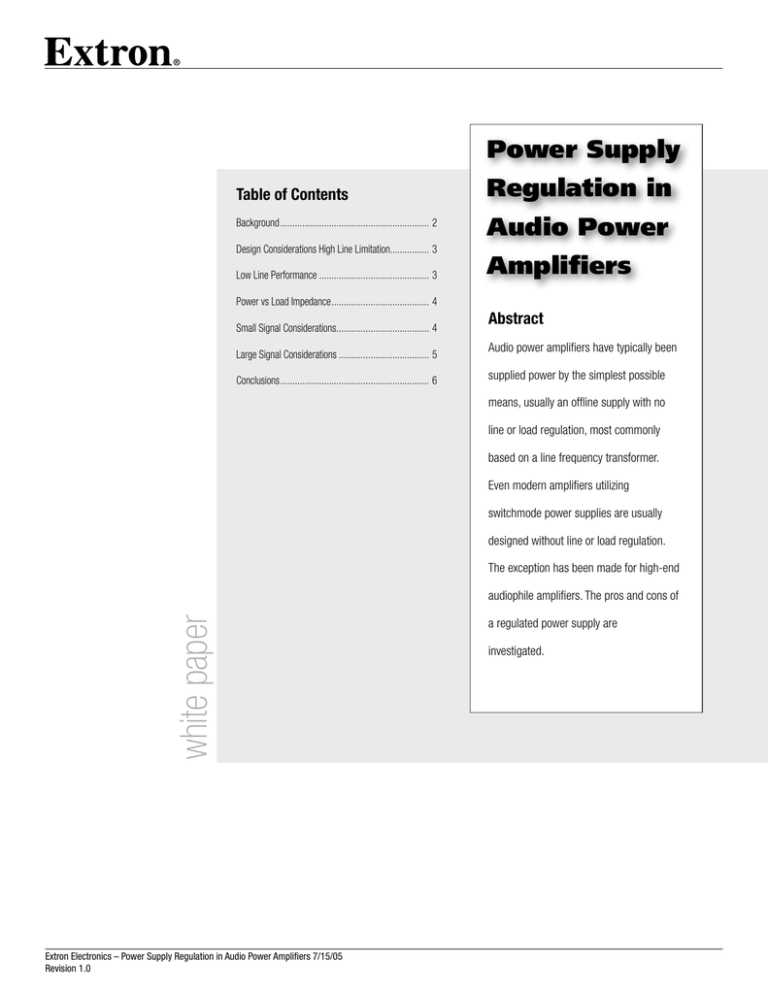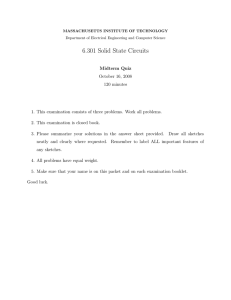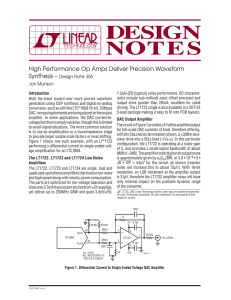
Power Supply
Table of Contents
Background ............................................................. 2
Design Considerations High Line Limitation................ 3
Low Line Performance ............................................. 3
Regulation in
Audio Power
Amplifiers
Power vs Load Impedance ........................................ 4
Small Signal Considerations...................................... 4
Large Signal Considerations ..................................... 5
Conclusions ............................................................. 6
Abstract
Audio power amplifiers have typically been
supplied power by the simplest possible
means, usually an offline supply with no
line or load regulation, most commonly
based on a line frequency transformer.
Even modern amplifiers utilizing
switchmode power supplies are usually
designed without line or load regulation.
The exception has been made for high-end
white paper
audiophile amplifiers. The pros and cons of
Extron Electronics – Power Supply Regulation in Audio Power Amplifiers 7/15/05
Revision 1.0
a regulated power supply are
investigated.
white paper
AC
Background
DC
Zline
Xfmr
Rect
A typical power supply in an audio power amplifier is shown in Fig. 1. The AC line is
Cap
passed through a transformer and rectified. More recent offerings have been in the form
of Fig. 2, where the AC line is rectified first, then converted to high frequency AC with
semiconductor switches, passed through a transformer and rectified.
Fig. 1: Unregulated Line Frequency Supply
Neither of these configurations offers line regulation, which is the ability of a power
supply to maintain a constant output voltage with variation in the AC line. The output
voltages of these circuits are a function of the AC line voltage, shown in Fig. 3. Also
AC
DC
lacking in both configurations is load regulation, which is the ability of a power supply to
maintain a constant output voltage when load power draw is varied. The output voltages
Zline
Rect
Cap
Switch
Xfmr Rect
Cap
of these circuits are a function of the load power drawn, shown in Fig. 4.
A switching power supply with line and load regulation is configured as Fig. 2, but with
Fig. 2: Unregulated Switching Power Supply
additional control circuitry. It has substantially constant output voltage over a range of
line and load conditions. This paper explores the audio amplifier performance differences
in these approaches.
VONOM
VO
VNOM
VAC
Fig. 3: Unregulated Supply Output Voltage vs Line Voltage.
VO
IO
VODC
VOAC
VOMIN
Fig. 4: Unregulated Supply Output Voltage vs Load Current
Extron Electronics – Power Supply Regulation in Audio Power Amplifiers 7/15/05
Revision 1.0
2
white paper
Design Considerations
High Line Limitation
1000W
PO
When designing a power amplifier with an unregulated supply, the rail voltage at 15%
high line must be chosen so that no amplifier components are beyond their operating
750W
limits. If the limiting factor in the design is the voltage rating of these components, then
625W
nominal power output will be limited to what can be achieved by operating at about 15%
under their ratings. For example, an ideal amplifier operating with 63V rails can deliver
VAC
VLL VNOM VHL
1000W into 2 ohms, shown in Fig. 5.
If the 63V occurs at 15% high line, then the amplifier will operate from 55V rails at
Fig. 5: Unregulated Supply PO vs VAC
nominal line, and put out only 750W. The square law relationship between supply voltage
and output power means a small line voltage drop has a pronounced effect on output
power. The 750W power at nominal line assumes nominal line voltage is maintained at
the power supply input, as could be done with an autoformer.
Low Line Performance
When run from the unassisted AC line, the source impedance of the line, Zline in Fig. 1,
will cause the output voltage to sag even lower. Zline will vary with location, but a high
powered amplifier can easily sag the line voltage 10%. Even if one piece of unrelated
high power equipment drags the AC line voltage down, all amplifiers on that circuit will
see the same decreased line voltage. This means that a nominal 750W amplifier may
see rails of only 50V in a real world application, with output power limited to 625W,
down from our 1000W limit by one-third
The peak available output in this example varies from 625W to 1000W. When specifying
a loudspeaker to run from this amplifier the driver excursion limits must be considered.
The high line limit of 1000W can be reached on a transient basis, and will cause driver
overexcursion if not accounted for.
Extron Electronics – Power Supply Regulation in Audio Power Amplifiers 7/15/05
Revision 1.0
3
white paper
Power vs Load Impedance
An ideal amplifier running from regulated rails has the characteristic of doubling output
1000W
power when load impedance is halved, as shown in Fig. 6. So an ideal amplifier rated
at 250W / 8 ohms would give 500W / 4 ohms and 1000W / 2 ohms. An unregulated
PO
amplifier could be designed in several ways. It could be limited at 8 ohms due to voltage
500W
constraints, and would start at 250W / 8 ohms, but power would not double with a
250W
halving of load impedance. A typical product delivers 350W /4 ohms, and 500W / 2
ohms, shown as Unregulated Supply 1 in Fig. 6. So in comparison to the regulated
8ohm
4ohm
2ohm
ZLOAD
Regulated Supply
Unregulated Supply 1
Unregulated Supply 2
Optimized Regulated Supply
Fig. 6: Output Power vs Load Impedance
amplifier, the unregulated amplifier has less power at 2 ohms for a given 8 ohm power.
Fig. 6. Output Power vs Load Impedance Another design approach could have the
unregulated amplifier match the 1000W 2 ohm power rating of the regulated amplifier,
which would typically achieve give 750W / 4 ohms, and 500W / 2 ohms. So in this
comparison the unregulated amplifier, shown as Unregulated Supply 2 in Fig. 6, has
more 8 ohm power for a given 2 ohm power. A third unregulated design could match the
4 ohm power of the regulated amplifier, with 2 ohm power falling below the regulated
rating, and 8 ohm power rising above the regulated rating.
With a regulated power supply another option becomes apparent, that of optimization of
the power supply voltage for each load impedance. This means that an amplifier could
have a variable or selectable rail voltage that would produce 1000W at 2 ohms, 1000W
at 4 ohms, or 1000W at 8 ohms
Small Signal Considerations
Generally, the effects of regulation should not come into play at low signal levels.
The possibility exists that an amplifier driven at high power can cause enough AC
components in the power supply rails to affect the gain stages of the amplifier if they
are not designed to safeguard against this. An example would be where a differential
pair used in the front end has its current source configured as a high value resistor tied
to one of the rails. In this case, supply ripple would actually modulate the loop gain of the
amplifier, affecting stability and clip recovery characteristics. Another possibility is that
one channel of a stereo amplifier could be driven at high power, modulating the rails of a
second channel driven lightly. In this case, we are relying on the power supply rejection
ratio of the power amplifier to keep the ripple out of the signal output. Fortunately, PSRR
is very good at low frequencies for any well designed amplifier, so this effect should be
minimal.
Extron Electronics – Power Supply Regulation in Audio Power Amplifiers 7/15/05
Revision 1.0
4
white paper
Large Signal Considerations
Most of the difference seen when using regulation occurs at high power, at or near
clipping. When heavily loaded the unregulated supply has line frequency related
components as well as output frequency related components. These are visible at
clipping in the envelope modulation of the output. Since the line frequency related
components are not harmonically related to the audio signal, the spectrum at clipping
will contain components that are not harmonically related. Fig. 7 shows the audio
output of an amplifier driven with a 200mS duration 100Hz tone burst, running from an
unregulated 60Hz supply. There are several effects immediately visible.
Fig. 7: Unregulated Supply Burst Output Waveform
The first effect seen is the high peak power available for the first cycle compared to the
much lower steady state power. This is the transient headroom or dynamic headroom,
which could be seen as a benefit if the program material had short peaks of this duration.
With bursts of significant duration this effect is of minor relevance, though.
The second salient feature of the output is the envelope modulation occurring at the
beat frequency of 20Hz. This causes the clipped waveform to contain this beat frequency
component, which is not harmonically related to the 100Hz fundamental.
The third feature noted is the inconsistency in slopes of the clipped sinewave half
cycle peaks, slope being dependent on position in the envelope. We see a 5:1 range
of slopes.
Fig. 8 shows the audio output of an amplifier driven with a 200mS duration 100Hz
Fig. 8: Regulated Supply Burst Output Waveform
tone burst, running from a regulated switching power supply. We see that the clipped
peaks all have a uniform horizontal slope, with the first peak the same as all subsequent
peaks.
Fig. 9. Spectrum of Unregulated and Regulated Burst Outputs. Fig. 9 shows the spectrum
100Hz
300Hz
of the signals from Fig. 7 and Fig. 8. There are quite a few differences, predictable
500Hz
by inspection of the waveforms. There are many components present that are not
harmonically related to the fundamental in the unregulated case. The heterodyned
200Hz
waveform of the unregulated case shows sidebands on the fundamental and harmonics,
as well as altogether new peaks when compared to the regulated case.
Fig. 9: Spectrum of Unregulated and Regulated Burst Outputs
Extron Electronics – Power Supply Regulation in Audio Power Amplifiers 7/15/05
Revision 1.0
5
white paper
The magnitudes of these components are not negligible, as shown below with magnitudes
relative to the fundamental. The magnitude of the sidebands of the fundamental
measured at 80Hz and 120Hz are only down 35dB, as is the 220Hz component.
Note there is 200Hz present in the regulated amplifier due to clipping asymmetry,
while the unregulated amplifier has significant components at 180Hz and 220Hz.
20Hz
-35 dB
80Hz
-35 dB
120Hz
-38 dB
180Hz
-43 dB
220Hz
-35 dB
Table 1. Magnitudes of Selected Unregulated Supply Frequency Components.
The audible effect of this should be apparent to even the untrained ear in a listening
test, manifesting itself as a level dependent modulated hum and buzz. In the case where
the signal frequency harmonics are close to the line frequency harmonics, the effect
may sound like a slightly out of tune string. Subjective listening tests of amplifiers with
similar specs can show audible differences at high power; the above effect will vary
significantly from one design to the next, and this may explain some of the difference
between amplifiers. Since this occurs only at clip the effect can be eliminated entirely
by sizing the amplifier such that it never clips.
Conclusions
Line and load regulation in power supplies for audio power amplifiers has been reviewed.
Some design limitations have been shown. Small signal effects have been dismissed
as negligible, but large signal effects have been shown to be significant. The envelope
modulation of the output has been shown to give rise to significant components that are
not harmonically related to the fundamental. The possibility that this effect is audible
and partly responsible for perceived sonic differences between amplifiers has been
acknowledged; further empirical work may verify this.
Extron Electronics – Power Supply Regulation in Audio Power Amplifiers 7/15/05
Revision 1.0
6
white paper
Extron Electronics, headquartered in Anaheim, CA, is a leading manufacturer of professional A/V system products including computer-video interfaces, switchers, matrix switchers,
distribution amplifiers, video scalers, scan converters, signal processing devices, Ethernet control interfaces, and high resolution cables. Extron products are used to integrate video
and audio into presentation systems for today’s high tech boardrooms, presentation/training centers, university lecture halls, and other applications.
For additional information, please call an Extron Customer Support Representative at: 800.633.9876 (inside USA and Canada only) or 714.491.1500 for Extron USA;
+800.3987.6673 (inside Europe only) or +31.33.453.4040 for Extron Europe; +800.7339.8766 or +65.6383.4400 for Extron Asia; +81.3.3511.7655 for Extron Japan.
www.extron.com
Copyright © 2005 All rights reserved.
Extron Electronics – Power Supply Regulation in Audio Power Amplifiers 7/15/05
Revision 1.0
7





